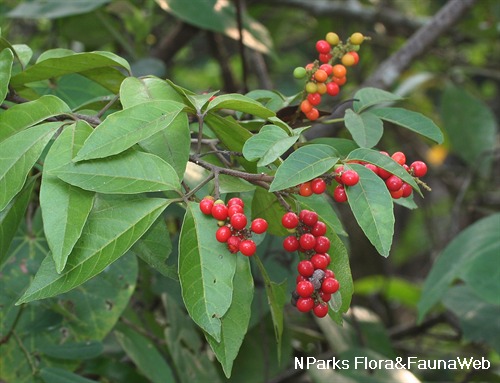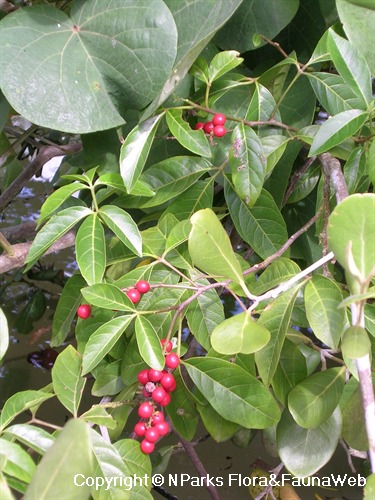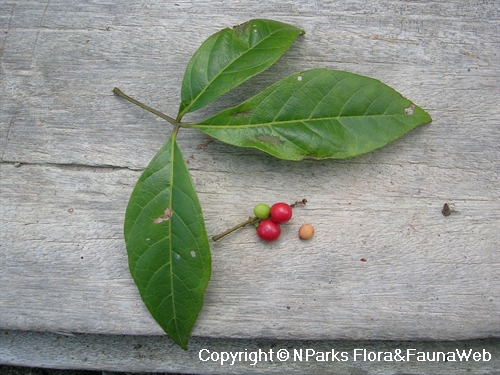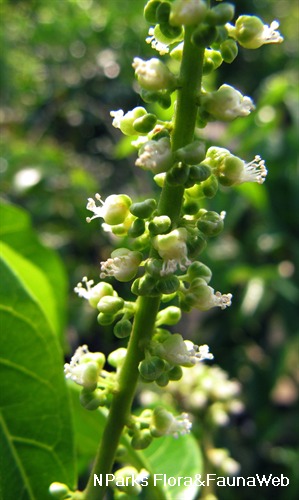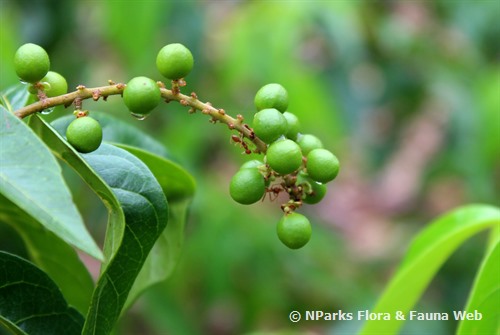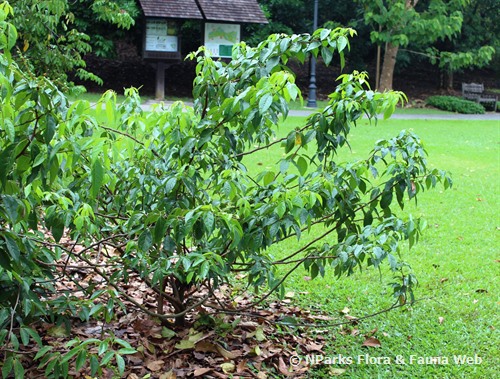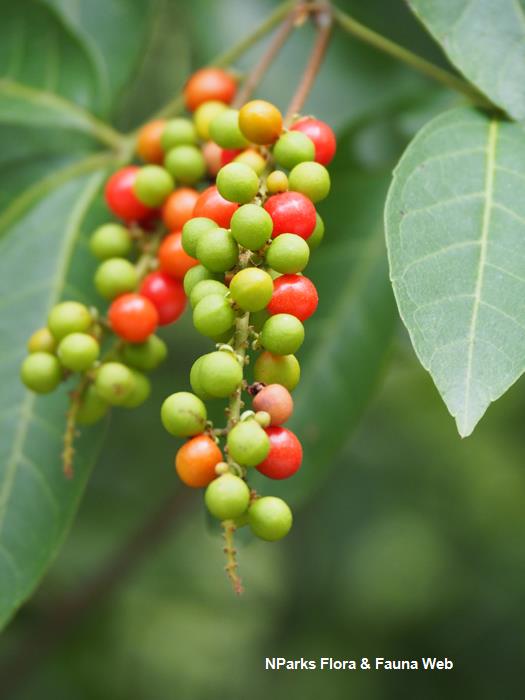
Back
Allophylus cobbe (L.) Reausch.
| Family Name: | Sapindaceae |
| Common Name: | Tit-berry, 广布异木患 |
Tit-berry is a native shrub of Singapore that can sometimes grow into a climber of up to 3 m or less locally. Its compound leaves, with three leaflets, are spirally arranged and have toothed edges. Its festive looking fruit are borne in clusters and are small, round and orange-red in colour. These are eaten and dispersed by frugivorous birds. Tit-berry grows in coastal to inland forests and is used as traditional medicine to treat fever and stomachache in Bangladesh and Maldives, respectively. Its wood is not known to be durable and is used as material for making temporary structures, canes and knife handles in Malesia.
Name
Classifications and Characteristics
| Plant Division | Angiosperms (Flowering Seed Plants) |
|---|---|
| Plant Growth Form | Shrub |
| Lifespan (in Singapore) | Perennial |
| Mode of Nutrition | Autotrophic |
| Maximum Height | 3 m to 25 m |
Biogeography
| Native Distribution | Pantropics, Malesia and Australia |
|---|---|
| Local Conservation Status | Native to Singapore (Least Concern (LC)) |
Description and Ethnobotany
| Growth Form | It is usually a shrub or climber up to 25 m tall, but in Singapore, it is usually 3 m or less. |
|---|---|
| Foliage | Its spirally arranged, shortly-stalked leaves are usually trifoliate (bearing three leaflets). They have membranous, fleshy or leathery leaf blades that are usually oval or oblong, 2.5 - 35 cm by 1.5 - 22 cm, and somewhat toothed at the margins. Its dried, dull and shiny leaf blades are greenish to greyish or dark brown above, and light green to reddish-brown below. |
| Flowers | Its shortly-stalked flowers are faintly fragrant, up to 2.5 mm wide, with white petals, and green to whitish sepals. They are found on branched or unbranched axes of the flowering shoot up to 40 cm long. |
| Fruit | Its 1-seeded fruits are round, 4.5–13 by 3.5–8 mm, smooth to slightly wrinkled, and ripen dull orange-red. |
| Habitat | It grows in coastal to inland forests, from lowland up to 2,000 m altitude. In Singapore, it grows at the landward edge of mangrove forest, and sandy beaches. It occurs locally in the vicinity of Kranji Reservoir, Sembawang, Pasir Panjang, Pulau Ubin, and Pulau Tekong, as well as other coastal sites. |
| Associated Fauna | It is the preferred local food plant for caterpillars of the moths, Cleora injectaria and Gonodontis clelia. Its flowers are visited by bees. Its fruits are also eaten and dispersed by birds. |
| Ethnobotanical Uses | Medicinal: The bark is applied to burns and rigid abdomen. Fever and stomach-ache can be treated using the pulped leaves, or an extraction or decoction of them, as well as a decoction of the roots and bark. Timber & Products: The wood, though said to be hard and not very durable, is usually used for temporary and indoor structures. It is also used as firewood, and for making canes, and hilts. Others: Children can also use extracts of the leaves as mouthwash. The fruits are used to make fish poison. |
Landscaping Features
| Desirable Plant Features | Ornamental Foliage, Ornamental Fruits |
|---|---|
| Landscape Uses | Coastal, Parks & Gardens, Beachfront / Shoreline, Hedge / Screening, Riverine |
Fauna, Pollination and Dispersal
| Fauna Pollination Dispersal Associated Fauna | Bird-Attracting |
|---|
Plant Care and Propagation
| Light Preference | Full Sun |
|---|---|
| Water Preference | Moderate Water |
| Plant Growth Rate | Moderate |
| Rootzone Tolerance | Drought Tolerant, Moist Soils, Waterlogged Soils, Well-Drained Soils, Saline Soils / Salt Spray |
| Propagation Method | Seed, Air-Layering |
Foliar
| Mature Foliage Colour(s) | Green |
|---|---|
| Mature Foliage Texture(s) | Glossy / Shiny |
| Foliar Shape(s) | Non-Palm Foliage |
| Leaf Area Index (LAI) for Green Plot Ratio | 4.5 (Shrub & Groundcover - Dicot) |
Floral (Angiosperm)
| Flower Colour(s) | White |
|---|
Fruit, Seed and Spore
| Mature Fruit Texture(s) | Smooth, Wrinkled |
|---|
Image Repository
Others
| Master ID | 335 |
|---|---|
| Species ID | 1631 |
| Flora Disclaimer | The information in this website has been compiled from reliable sources, such as reference works on medicinal plants. It is not a substitute for medical advice or treatment and NParks does not purport to provide any medical advice. Readers should always consult his/her physician before using or consuming a plant for medicinal purposes. |

